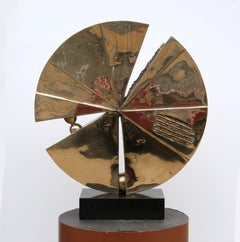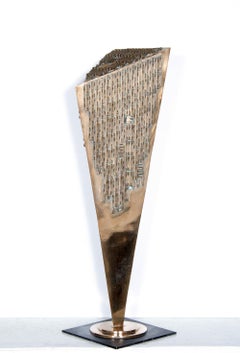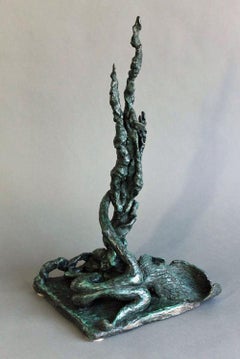Stefan Matty Vladescu Abstract Sculptures
to
1
1
Overall Width
to
Overall Height
to
2
2
1
1
2
2
5
196
119
91
84
2
Artist: Stefan Matty Vladescu
Epiphany
By Stefan Matty Vladescu
Located in Long Island City, NY
Artist: Stefan Vladescu, Romanian/American (1952 - )
Title: Epiphany
Year: 1994
Medium: Bronze Sculpture, signature and date inscribed
Size: 25 inch diameter x 1.5 wide
Base 3 x 8...
Category
1990s Surrealist Stefan Matty Vladescu Abstract Sculptures
Materials
Bronze
Pandora's Box, Polished Bronze Sculpture, by Stefan Vladescu 1993
By Stefan Matty Vladescu
Located in Long Island City, NY
Artist: Stefan Matty Vladescu, Romanian/American (1952 - )
Title: Pandora's Box
Year: 1993
Medium: Bronze Sculpture, signature and date inscribed
Size: 34.5 in. x 10 in. x 10 in. (87...
Category
1990s Modern Stefan Matty Vladescu Abstract Sculptures
Materials
Bronze
Related Items
Woman Lying Down & Growing with Tree bronze sculpture by Yulla Lipchitz
Located in Hudson, NY
Organic, abstract bronze sculpture by Yulla Lipchitz of a woman lying down with a tree.
About this artist: Yulla Lipchitz, née Halberstadt, was born on April 21, 1911 in Berlin, Ge...
Category
1970s Modern Stefan Matty Vladescu Abstract Sculptures
Materials
Bronze
$3,775
H 16 in W 7 in D 8 in
Gymnast (bust), Bronze Sculpture
By Richard MacDonald
Located in Aventura, FL
Bronze sculpture with marble base. Incised artist signature and date. Sculpture size 13.5 x 7 x 6 inches (including base). Sculpture is in excellent condition (marble base has a c...
Category
1980s Surrealist Stefan Matty Vladescu Abstract Sculptures
Materials
Bronze
$4,875 Sale Price
25% Off
H 13.5 in W 7 in D 6 in
Eugene Caples "Bronze Sculpture I" Abstract Bronze Sculpture
By Eugene Caples
Located in Detroit, MI
This small exquisite "Bronze Sculpture I" is in excellent condition and a perfect example of Eugene Caples craftsmanship. Although it is mainly abstract, there are bits that look figurative either an arm or a leg attempting to emerge from a fold or attempting to hold a pose such as in yoga. It cries out to be touched and held, looked at and caressed. The beautiful patina on the surface gives voice to the many hands that have done these things.
Eugene Caples is a designer and craftsman who worked in Kansas City in the 1960s and later through the early 21st century. He attended the Kansas City Art Institute, earning his Bachelors of Fine Arts in Industrial Design in 1959. In 1963 he was accepted to Cranbrook Academy of Art, Bloomfield Hills, Michigan. The Cranbrook Academy of Art was designed by architect and faculty member, Eliel Saarinen who collaborated with Charles and Ray Eames on chair and furniture design. Numerous creative artists are alumni of Cranbrook and include: Harry Bertoia, Florence Knoll, Jack Lenor Larsen, Donald Lipski, Duane Hanson, Nick Cave, Hani Rashid, George Nelson, Urban Jupena (Nationally recognized fiber artist), Artis Lane (the first African-American artist to have her sculpture, "Sojourner Truth," commissioned for the Emancipation Hall in the Capital Visitor Center in Washington DC), Cory Puhlman (televised Pastry Chef extraordinaire), Thom O’Connor (Lithographs), and Paul Evans (Created Brutalist-inspired sculpted metal furnishings.)
Gene worked...
Category
Late 20th Century American Modern Stefan Matty Vladescu Abstract Sculptures
Materials
Bronze
$1,950
H 6.5 in W 2.75 in
Latin American Raúl Valdivieso Bronze Organic Abstract Sculpture
By Raúl Valdivieso
Located in Washington, DC
Striking bronze organic sculpture by Latin American sculptor Raúl Valdivieso (Chilean, 1931-1993). Valdivieso is known for his reinterpretation of the ...
Category
1960s Modern Stefan Matty Vladescu Abstract Sculptures
Materials
Bronze
$1,925 Sale Price
30% Off
H 15 in W 12 in D 8 in
Curved Form -original geometrical abstract sculpture-artwork-contemporary Art
Located in London, Chelsea
This exceptional artwork is currently on display and available for sale at Signet Contemporary Art Gallery and online.
"Curved Form" by David Sprakes is an original table-top bronze...
Category
21st Century and Contemporary Modern Stefan Matty Vladescu Abstract Sculptures
Materials
Bronze
$3,894
H 16.54 in W 9.85 in D 3.55 in
Paul Maxwell Rare Sand Cast Bronze & Wood Brutalist Totem Sculpture 1967
By Paul Maxwell
Located in Dallas, TX
Paul Maxwell Rare Sand Cast Bronze & Wood Brutalist Totem Sculpture (1967, Commissioned)
A striking and rare example of Paul Maxwell’s early sculptural work, this monumental totem wa...
Category
Mid-20th Century Modern Stefan Matty Vladescu Abstract Sculptures
Materials
Bronze
$25,000
H 8 in W 8 in D 70 in
Large Salvador Dali Surrealist Bronze Portrait Sculpture Mexican Master Aguilar
Located in Surfside, FL
Carlos Aguilar y Linares, Mexican Sculptor (1945-2010)
Sculpture chose him. In his hands and his soul he always had the necessary impulse to create wi...
Category
20th Century Surrealist Stefan Matty Vladescu Abstract Sculptures
Materials
Marble, Bronze
$5,500
H 27 in W 10.5 in D 8 in
Peace Menorah
By Salvador Dalí
Located in Missouri, MO
Peace Menorah, 1980
Salvador Dali (Spanish, 1904-1989)
Cast Bronze with Silver Finish mounted to Jerusalem Stone base
Signed Lower Center
Edition H.C. Lower Center (aside from the ed...
Category
1980s Surrealist Stefan Matty Vladescu Abstract Sculptures
Materials
Stone, Silver, Bronze
Daum Montre Molle Sculpture
By Salvador Dalí
Located in Hollywood, FL
ARTIST: Salvador Dali
TITLE: Daum Montre Molle Sculpture
Designed by Salvador Dali for Daum
MEDIUM: pate de verde glass and bronze sculpture. Pate de ve...
Category
Late 20th Century Surrealist Stefan Matty Vladescu Abstract Sculptures
Materials
Glass
Bronze Heron Sculpture by Wayne F Williams
Located in Rochester, NY
Bronze heron by American sculptor Wayne Williams. Signed and dated 1993. Edition 2/2. Mounted on a walnut base.
From Finger Lakes Magazine 2001:
Art is everywhere in the Finger Lakes. Inspired by the region’s diverse scenery and lifestyles, artists pursue their creativity outdoors, in studios and in workshops. In the many well-established museums and galleries or at the newer fledgling arts organizations, a wide array of artistic styles and talents are represented. Often the artists, like Wayne Williams, share their artistic skill and passion through teaching at local colleges.
Williams, who is retired after a 35-year career at Finger Lakes Community College, found his calling there. “I didn’t want to teach in public schools,” explains Williams of his career choice. “I wanted to be at the college level. CCFL (the Community College of the Finger Lakes, as it was then known) was literally creating a college, right from scratch.” The year was 1968 and Williams was charged with coordinating the new college’s art program.
Rand Darrow, a CCFL student in that first year, remembers attending Williams’ art classes in a commercial building on Main Street just south of the railroad tracks in Canandaigua. Darrow appreciated his instructor’s relaxed manner. “He was a great teacher,” recalls Darrow, “cracking jokes all the time.” Darrow graduated with a major in Liberal Arts and continued on to SUNY Oswego where he earned a BA in fine arts. He taught art to elementary and middle school students for 30 years.
These days Williams and Darrow typically cross paths at the Wayne County Arts Council in Newark where Williams and his wife, Marleen, are heavily involved. Williams offers classes in figure drawing and sculpture and hangs the gallery’s shows, including his former student’s “Slavic Tales of Novgorod” this past August. “I’d like to take a sculpture class from him,” says Darrow.
In 2003 when Williams retired, the college honored him and another retiring art professor, Tom Insalaco, by renaming its art gallery the Williams-Insalaco Art Gallery. It was known formerly as Gallery 34 to recognize its origins at 34 North Main Street in Canandaigua. Williams held professor’s rank from 1976 and served as director of the art gallery beginning with its opening in 1983.
Williams, who was born and raised in Newark, New York, says he began doing art at about age 8. By the time he was in junior high school his career direction seemed clear. He received local and national awards for his art and a scholarship to Syracuse University, from which he graduated in 1958 with a Bachelor of Fine Arts in sculpture. He continued with graduate work at Syracuse, receiving an MFA in sculpture in 1962. He worked full time as a sculptor until he began teaching.
At one point Williams admits he wanted to be a painter, but didn’t want to adopt the abstract expressionist style in vogue in the 1950s, preferring to pursue the realist tradition. He advises any would-be artist to “do what you do because you love it.”
After graduation he traveled abroad, spending time in Belgium, the land of his ancestors. “My family’s name was originally Willems,” explains the 73-year old who still relishes the time spent in the Flemish countryside. Williams speaks excitedly about art, referencing the lives of great artists. He acknowledges that American artists do not have the same stature as those in Europe, where Old Masters like Brueghel and Rembrandt are national heroes.
These days the energetic Williams, known primarily as a sculptor, is active at the Phelps Arts Center where he is on the board of directors. In mid-September when a group of visitors on a motor coach tour explored artworks displayed in the beautiful church-turned- gallery, they were treated to a large number of Williams’ bronze and metal sculptures, along with his charcoal drawings. “I’ve always loved his work because he deals with things, people, and animals you understand,” says the center’s Director Emeritus Marion Donnelly, who has known him for many years.
Outside the Phelps Community Historical Society, Williams’ life-size figure of a farmer raises his pitchfork above a colorful flower garden on the front lawn. Inspired by the peasants working the fields in Europe, the metal figure is shown with wooden shoes. This is Williams’ largest copper piece, loaned to the Phelps museum in connection with Artistry in Sculpture, a community exhibition in 2009. Williams added a new base using a metal wagon...
Category
20th Century Modern Stefan Matty Vladescu Abstract Sculptures
Materials
Bronze
"Zofar" Boaz Vaadia, Human Body, Bronze and Stone, Anthropomorphic Sculpture
By Boaz Vaadia
Located in New York, NY
Boaz Vaadia
Zofar, 1997
Bronze, bluestone, and boulder
Overall 20 x 29 x 27 inches
From the edition of 7
Provenance
Elaine Baker Gallery, Boca Raton, Florida
Boaz Vaadia is the in...
Category
1990s American Modern Stefan Matty Vladescu Abstract Sculptures
Materials
Stone, Bluestone, Bronze
$40,000
H 20 in W 29 in D 27 in
Homage to Newton (bronze sculpture)
By Salvador Dalí
Located in Aventura, FL
Bronze with patina sculpture. Incised signature by the artist and stamp numbered with foundry and date. From the edition of 350. Size including marble plinth approx. 15 x 8.5 x 3.5 ...
Category
1980s Surrealist Stefan Matty Vladescu Abstract Sculptures
Materials
Bronze
$14,625 Sale Price
25% Off
H 14.6 in W 6.3 in D 2.8 in
Stefan Matty Vladescu abstract sculptures for sale on 1stDibs.
Find a wide variety of authentic Stefan Matty Vladescu abstract sculptures available for sale on 1stDibs. You can also browse by medium to find art by Stefan Matty Vladescu in bronze, metal and more. Much of the original work by this artist or collective was created during the 1990s and is mostly associated with the Surrealist style. Not every interior allows for large Stefan Matty Vladescu abstract sculptures, so small editions measuring 10 inches across are available. Customers who are interested in this artist might also find the work of Igael Tumarkin, Salvador Dalí, and Walter Furlan. Stefan Matty Vladescu abstract sculptures prices can differ depending upon medium, time period and other attributes. On 1stDibs, the price for these items starts at $9,500 and tops out at $15,000, while the average work can sell for $12,250.


